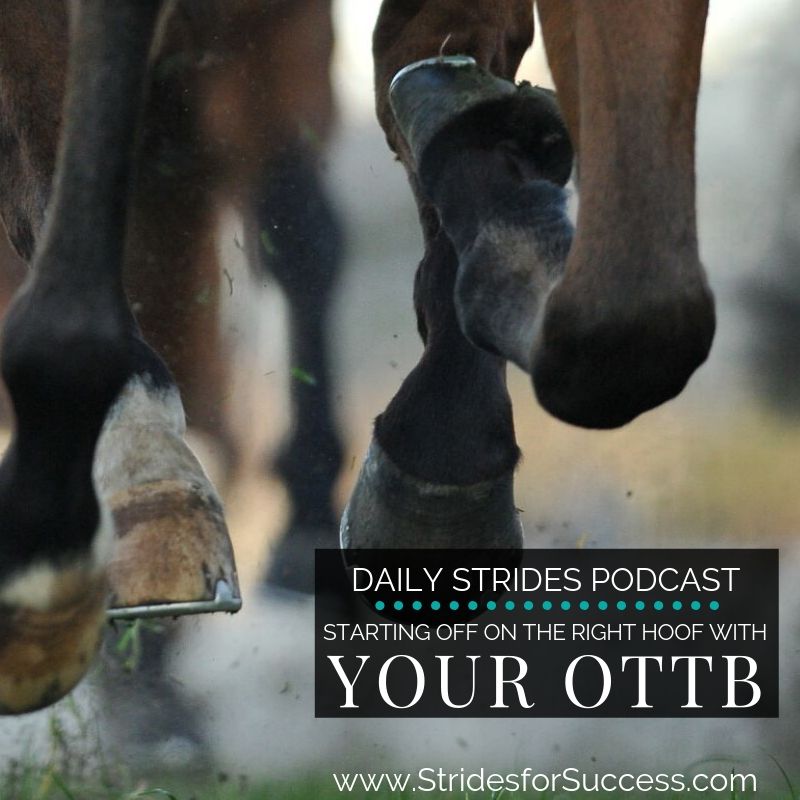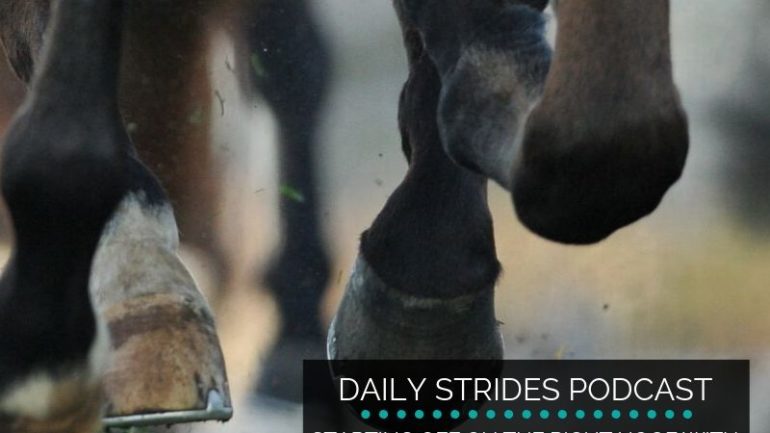
Starting a new horse or pony is exciting. Getting started with your OTTB is the same. You have this golden opportunity to have a huge positive impact on this horse, which will hopefully filter through the rest of his life.
However, for many riders, the itchy feeling that is ‘let’s get started already’ can cause them to overlook a couple of things, which can often result in setbacks later down the line…
For many of us, we source our OTTB’s or retired racehorses straight from the track. They literally ran their last race where they, usually, found themselves watching the winner romp home from more than a few lengths back. This may have happened just one time too many, and either the owners or the trainer will have decided that this particular horses talent must lie elsewhere…
In this episode of the Daily Strides Podcast, I want to dig in a little to a few things I suggest you pay attention to when starting working with your ex-racehorse. Hopefully, they will help you to avoid some delays later on in your training with your OTTB.
Not All OTTB’s Need ‘Down-Time’
There is a big adjustment period for your horse when he is changing careers. Most of the rhythms, routines and things he was familiar with at the track will now change.
However, rather than your horse ‘learning to be a horse again’, he must rather learn to adjust to his new life. His new lifestyle and career…
In my experience, many horses do quite well, and even thrive, when they go straight from race-track to civilian life. They adjust quickly to a quieter pace of life. Keep in mind that ‘how things are done here’ is also an adjustment they must cope with.
That being said, there are horses who are just completely stressed from their track experience. Obviously they will need a longer and ‘softer’ introduction period where their new career is concerned.
Feeding & Condition
It is important to recognize that there is a vast difference between ‘fit’ and ‘thin’. Fit, or lean, is when your horse does not have a lot of body fat but does have muscle. Thin is when he has neither.
In essence, thin is when you have a ‘Skinny Malink’ on your hands; and this needs to be taken into consideration when planning anything for your horse.
Your horses state of mind plays a huge part when putting together a suitable feeding program. A feeding program him in a way that will help him adjust to his new life.
The horse’s actual physical condition, temperament and present state of mind will be the key indicators when working out a suitable feeding program. Bear in mind that this will constantly evolve and change as your horse develops.
Tack & Equipment
One of the biggest misconceptions surrounding OTTBs is that they are already fully trained and ‘ready to ride’… Hmmm…. Not actually! What they have been ridden and worked in up to this point is going to look different to what the average pleasure horse ‘wears’ on a daily basis.
The other common mistake riders make when it comes to tack is falling into a bit of a rut. You find something that, for that instance, works; so therefore you use it ALL THE TIME!
It is also worth noting that what fits your horse starting out probably won’t fit so well a few months into his ‘re-schooling’. When your retired racehorse comes off the track, he is a lean mean running machine! An extremely ‘racing fit’ horse is conditioned and shaped a lot different to a ‘of average fitness’ pleasure horse.
Remember to re-assess all tack regularly for fit. Equally as important is for what is needed and ‘working’. Bits, nosebands and martingales in particular should be re-evaluated as your horse develops.
Don’t Assume Anything…
It seems so obvious, and yet it is something that trips so many OTTB owners up before they ever really get started. Particularly the assumption that because he was in ‘regular work’, he’s good to get started with your particular discipline.
The simple fact is that most OTTBs don’t have much, if any, basic training when they come off the track. They just don’t understand…
You should also be aware that what was allowed or even encouraged at the track might be different than what you want. In fact, it might even the exact opposite! This is especially true where certain behaviours are concerned… Standing patiently still while waiting for you to mount up is just one!
Your Versatile OTTB
So, it goes without saying that I am a big fan of the wonderful ‘retired racehorse’. Your OTTB really does have the potential to turn his hoof to almost anything.
How you approach your initial training or re-schooling will play a huge part in how successful he is throughout the rest of his riding life…
With this in mind, it is so important to invest a little time up front to make sure all the ‘nitty gritty’ details are taken care of. This has the potential to really make an impact later on in the journey.
I have created a free ‘Checklist’ you can use to help you get started on the right hoof. It contains a ‘healthcare journal’ as well, which will ensure that you don’t forget or overlook any of those important dates and checks. You can get your free copy by CLICKING HERE
Happy Riding
Lorna
Other episodes or resources similar to this topic:-
- FREE OTTB Checklist & Healthcare Journal
- Setting Up Your OTTB for Success Off the Track
- Socializing Your Horse to Riding in a Group
- Working on Relaxation with Your OTTB – www.LornaLeeson.com
- Making Progress with Your OTTB – www.LornaLeeson.com
- Join the free Facebook group HERE
- The Daily Strides Podcast on iTunes
- Daily Strides Podcast on Google Play
- The Daily Strides Podcast on Stitcher Radio
- Join Daily Strides Premium
GROUNDPOLES FREEBIE
SUBSCRIBE TO GET THE PODCAST FREEBIE

